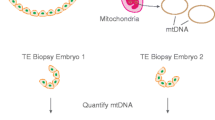Abstract
Patients: The study was undertaken to test whether human telomerase reverse transcriptase (hTERT) transcripts in an individual blastomere could be used as an indicator for embryo development.
Methods: Group A consisted of day 3 normal cleaving embryos at 4- to 8-cell stage, which were surplus and not allocated for uterine transfer. Group B consisted of arrested or fragmented embryos at the same stage, which were considered to be compromised. After blastomere dissociation, RNA purification, reverse transcription, and hTERT PCR amplification, the amplified product was separated by 3% gel electrophoresis.
Results: Eighty-six (90.5%) of the 95 intact blastomeres in group A and 78 (70.9%) of the 110 blastomeres in group B demonstrated hTERT mRNA expression. The difference was statistically significant (P< 0.05, chi-square). Eight (38.1%) of the 21 embryos in group A and 22 (62.9%) of the 35 embryos in group B had at least one blastomere that did not express hTERT mRNA under this procedure. The difference was not significant (P> 0.05, chi-square).
Conclusions: General hTERT mRNA transcripts can be detected in most of the individual blastomeres but cannot be used as an indicator for early embryo development. Further investigations are necessary to elucidate its clinical application.
Similar content being viewed by others
References
Zakian VA: Telomeres: Beginning to understand the end. Science 1995;270:1601-1607
Preston RJ: Telomeres, telomerase and chromosome stability. Radiat Res 1997;147:529-534
Harley CB, Futcher AB, Greider CW: Telomeres shorten during aging of human fibroblasts. Nature 1990;345:458-460
Faragher RG, Kipling D: How might replicative senescence contribute to human aging? Bioessays 1998;20:985-991
Morin GB: The human telomere terminal transferase enzyme is a ribonucleoprotein that synthesizes TTAGGG repeats. Cell 1989;59:521-529
Dahse R, Fiedler W, Ernst G: Telomeres and telomerase: Biological and clinical importance. Clin Chem 1997;43:708-714
Kim NW, Piatyszek MA, Prowse KR, Harley CB, West MD, Ho PL, Coviello GM, Wright WE, Weinrich SL, Shay JW: Specific association of human telomerase activity with immortal cells and cancer. Science 1994;266:2011-2015
Shay JW, Gazdar AF: Telomerase in the early detection of cancer. J Clin Pathol 1997;50:106-109
Fossel M: Telomerase and the aging cell: Implications for human health. JAMA 1998;279:1732-1735
Weinberg RA: Telomeres. Bumps on the road to immortality.Nature 1998;396:23-24
Fujisawa M, Tanaka H, Tatsumi N, Okada H, Arakawa S, Kamidono S: Telomerase activity in the testis of infertile patients with selected causes. Hum Reprod 1998;13:1476-1479
Brenner CA, Wolny YM, Adler RR, Cohen J: Alternative splicing of the telomerase catalytic subunit in human oocytes and embryos. Mol Hum Reprod 1999;5:845-850
Wright WE, Piatyszek MA, Rainey WE, Byrd W, Shay JW: Telomerase activity in human germline and embryonic tissues and cells. Dev Genet 1996;18:173-179
Xu J, Yang X: Telomerase activity in bovine embryos during early development. Biol Reprod 2000;63:1124-1128
Hardy K, Martin KL, Leese HJ, Winston RM, Handyside AH: Human preimplantation development in vitro is not adversely affected by biopsy at the 8-cell stage. Hum Reprod 1990;5:708-714
Nakamura TM, Morin GB, Chapman KB, Weinrich SL, Andrews WH, Lingner J, Harley CB, Cech TR: Telomerase catalytic subunit homologs from fission yeast and human. Science 1997;277,955-959
Meyerson N. Counter CM, Eaton EN, Ellisen LW, Steiner P, Caddle SD, Ziaugra L, Beijersbergen RL, Davidoff MJ, Liu Q, Bacchetti S, Haber DA, Weinberg RA: hEST2, the putative human telomerase catalytic subunit gene, is up-regulated in tumor cells and during immortalization. Cell 1997;90:785-795
Kilian A, Bowtell DD, Abud HE, Hime GR, Venter DJ, Keese PK, Duncan EL, Reddel RR, Jefferson RA: Isolation of a candidate human telomerase catalytic subunit gene, which reveals complex splicing patterns in different cell types. Hum Mol Genet 1997;6:2011-2019
Bodnar AG, Ouellette M, Frolkis M, Holt SE, Chiu C, Morin GB, Harley CB, Shay JW, Lichtsteiner S, Wright WE: Extension of life-span by introduction of telomerase into normal human cells. Science 1998;279:349-352
Krams M, Hero B, Berthold F, Parwaresch R, Harms D, Rudolph P: Full-length telomerase reverse transcriptase messenger RNA is an independent prognostic factor in neuroblastoma. Am J Pathol 2003;162:1019-1026
Wright DL, Jones EL, Mayer JF, Oehninger S, Gibbons WE, Lanzendorf SE: Characterization of telomerase activity in the human oocyte and preimplantation embryo. Mol Hum Reprod 2001;7:947-955
Eisenhauer KM, Gerstein RM, Chiu CP, Conti M, Hsueh AJ: Telomere activity in female and male rat germ cells undergoing meiosis and in early embryos. Biol Reprod 1997;56:1120-1125
Betts DH, King WA: Telomerase activity and telomere detection during early bovine development. Dev Genet 1999;25:397-403
Giorgetti C, Terriou P, Auquier P, Hans E, Spach JL, Salzmann J, Roulier R: Embryo score to predict implantation after in vitro fertilization: Based on 957 single embryo transfers. Hum Reprod 1995;10:2427-2431
Visser DS. Fourie FR: The applicability of the cumulative embryo score system for embryo selection and quality control in an in vitro fertilization/embryo transfer programme. Hum Reprod 1993;8:1719-1722
Bolton VN, Hawes SM, Taylor CT, Parsons JH: Development of spare human preimplantation embryos in vitro: An analysis of the correlations among gross morphology, cleavage rate, and development to the blastocyst. J In Vitro Fert Embryo Transf 1989;6:30-35
Leese HJ: Analysis of embryos by non-invasive methods. Hum Reprod 1987;2:37-40
Conaghan J, Hardy K, Handyside AH, Winston RM, Leese HJ: Selection criteria for human embryo transfer: A comparison of pyruvate uptake and morphology. J Assist Reprod Genet 1993;10:21-30
Grifo JA, Boyle A, Fischer E, Lavy G, DeCherney AH, Ward DC, Sanyal MK: Preembryo biopsy and analysis of blastomeres by in situ hybridization. Am J Obstet Gynecol 1990;163:2013-2019
Hisatomi H, Nagao K, Kanamaru T, Hiyama E: Levels of telomerase catalytic subunit mRNA as a predictor of potential malignancy. Int J Oncol 1999;14:727-732
Hartshorne GM: Factors controlling embryo viability. Hum Fertil 2001;4:225-234
Author information
Authors and Affiliations
Rights and permissions
About this article
Cite this article
Wang, CW., Yao, DS., Horng, SG. et al. Feasibility of Human Telomerase Reverse Transcriptase mRNA Expression in Individual Blastomeres as an Indicator of Early Embryo Development. J Assist Reprod Genet 21, 163–168 (2004). https://doi.org/10.1023/B:JARG.0000031249.37862.3a
Issue Date:
DOI: https://doi.org/10.1023/B:JARG.0000031249.37862.3a




